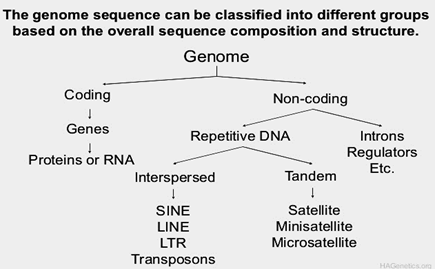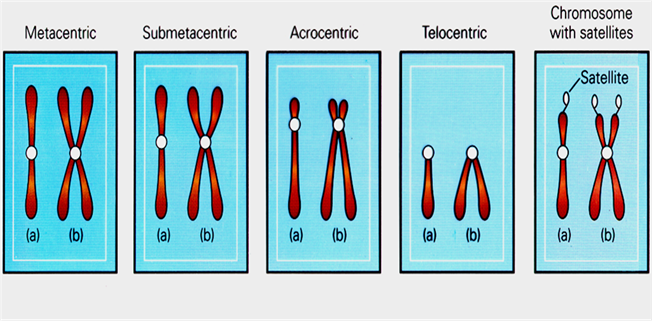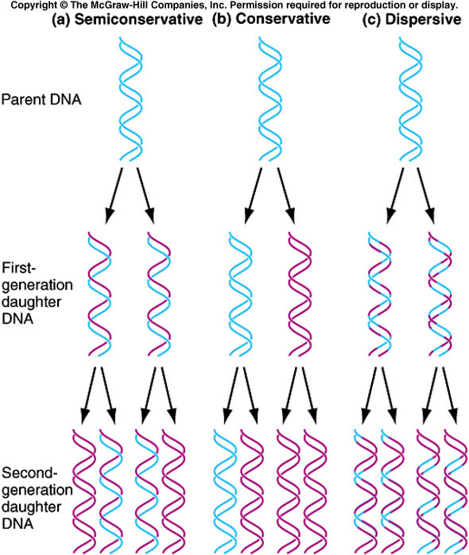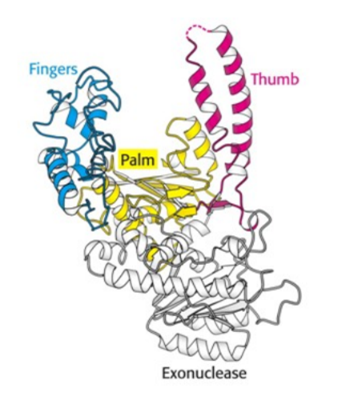Genetics and molecular biology
1/312
There's no tags or description
Looks like no tags are added yet.
Name | Mastery | Learn | Test | Matching | Spaced |
|---|
No study sessions yet.
313 Terms
Define genetics
field in biology that studied how traits are passed from parents to their offspring.
What is the central dogma of genetics
process where genetic information stored in genes is transcribed into mRNA and then translated into protein.
Define phenotype
the observable characteristic of an organims.
Define genotype
the genetic makeup of an organism that determines its traits.
Define gene
fundamental physical and functional unit of hereditary.
Role of DNA within a person
a unique blueprint for persons growth, differentiation, development and reproduction.
Features of eukaryotic cells
membrane-bound nucleus, single linear DNA molecules, mitochondria carries small amounts DNA.
Features of prokaryotic cells
no nuclei or membrane-bound organelles, genetic material in cytoplasm in nucleoid region, have circular chromosomes.
Similarities between eukaryotic and prokaryotic cells
both have DNA, plasma membrane, cytoplasm and ribosomes.
What did Gregor Mendel do?
interbred pea plants displaying different traits and discovered genes (hereditary factors) and studied these different genes in pea plants and concluded that inheritance follows rues (law of inheritance).
What is an N-glycosidic bond
a type of covalent bond joining carbohydrate molecules between N atom of an amine on a base and C1 on pentose sugar formed by condensation reaction.
What are nucleosides?
attachment of the purines or pyrimidines to the sugar (an N-glycosidic bond to the C1 on the sugar).
What is a nucleotide?
attachment of the nucleoside to one or more phosphate groups.
Roles of nucleotides
1. precursors of DNA and RNA.
2. ATP, universal currency of energy.
3. Adenine nucleotides are components of coenzymes NAD, FAD, CoA.
4. metabolic regulators.
5. activated intermediates in much biosynthesis.
Role of 1' bond on pentose carbon
N-glycosidic bond to the nitrogenous base.
Role of 2’ bond on pentose sugar
Determination of ribose (H) or deoxyribose (OH).
Role of 3’ bond on pentose carbon
Phosphodiester linkage between the C3 of one nucleotide and the C5 of the next nucleotide.
Role of 5' bond on pentose sugar
addition of phosphates to form nucleotide.
What are the complementary base pairs and number hydrogen bonds between them?
AT have 2 H bonds and CG have 3 H bonds.
Describe DNA double helix structure
anti-parallel strands one runs 5' to 3' and other3' to 5', held by H bonds, purine with pyrimidine base, one base pair is 3.4 angstroms (0.34nm), a complete turn of helix is 3.4nm, each turn contains major and minor groove.
Where in DNA double helix are van der walls interactions?
between stacked nitrogenous bases.
What is overall charge of DNA?
the phosphate backbone creates an overall negative charge.
What environment are cells in?
aqueous effecting strengths between water and DNA charged molecules.
What is role of counterions?
Cationic counterions (Mg2+) coordinate double helical structure.
How is DNA packaged?
Chromosomes(DNA and proteins) contain genetic material.
the genome comprises of all genetic material an organism possesses.
What do chromosomes look like in eukaryotic and prokaryotic cells?
Eukaryotic chromosomes are linear and packaged in a nucleus, while prokaryotic chromosomes are circular and located in the cytoplasm.
Importance of DNA sequnces
synthesis of RNA and cellular proteins.
2. proper segregation of chromosomes.
3. replication of chromosomes.
4. compaction of chromosomes so they can fit within living cells.
Describe viral genome
A viral genome can be composed of either DNA or RNA, and may be linear or circular in structure. Unlike cellular organisms, viral genomes are typically much smaller and rely on a host's cellular machinery for replication and expression.
Describe the bacterial genome
Bacteria can have one to four copies of the same chromosome and can have plasmids that are small, circular, double-stranded DNA molecules independent of chromosomal DNA. The bacterial genome is typically circular and compact, lacking introns and associated with histone-like proteins.
Describe DNA in eukaryotic cells
Chromosomes are located in the nucleus so need to be highly compacted.
How is DNA compacted?
DNA is compacted through processes such as wrapping around histones to form nucleosomes, further coiling into higher-order structures, and the use of scaffolding proteins to organize the chromatin within the nucleus. The DNA-protein complex is termed chromatin.
What is the difference between euchromatin and heterochromatin?
euchromatin is relaxed state (lighter) and heterochromatin is when tighly bound, compact and inaccessible (darker).
What causes variation in eukaryotic genome sizes?
the accumulation of repetitive DNA sequences which do not encode proteins.
Define sequence complexity
the number of times a particular base sequence appears in the genome.
What are the 3 types of repetitive sequences?
unique or non-repetitive.
moderately repetitive.
Highly repetitive.
How many times are unique/non-repetitive sequences found in the genome and give examples
found once or twice in genome and includes structural genes as well as intergenic areas.

How many times are moderately repetitive sequnces found in genome and give examples.
found a few hundred times and includes genes for rRNA and histones, origins of replication, and transposable elements.
How many times highly repetitive sequnces found in genome and describe them.
found tens of thousands to millions of times. each copy is relatively short . some sequences are interspersed throughout genome and others clustered together in tandem arrays.
What are the 3 types of DNA sequences required for chromosomal replication and segregation?
origins of replication.
centromeres.
telomeres.
What are the 5 types of chromosomes and where is the centromere located?

Name 3 ways chromosomes are arranged.
by size.
by banding pattern.
by centromere position.
What i the study of chromosomes called?
karyotyping methodology
Describe karyotyping
Usually performed on lymphocytes, chromosomes must be in metaphase, cells are processed and spread on microscopic slide an stained creating a unique G banding pattern to identify each chromosome and assess any abnormalities.
Describe human chromosome structure
human somatic cells contain 46 chromosomes (23 pairs), 44 autosomes and 2 sex chromosomes, gametic cells contain 23 chromosomes, telomeres and centromeres essential components, centromeres divide chromosomes into 2 arms (p and q) and is where spindle fibres attach during cell division, centromere location gives chromosome characteristic shape useful for identification.
Define allele
alternative form of a gene.
Define locus
position of a gene on a chromosome.
What is Mendel’s 1st law/segregation principle?
we assume that the outcomes are equally likely to occur where traits are usually determined by a pair of genes (one from each parent) and no blending of genes.
What is the genotypic and phenotypic ratio of mendel’s first law?
genotypic is 1:2:1
phenotypic is 3:1
What is Mendel’s 2nd law/independent assortment?
segregation of the members of any pair is independent of the segregation of other pairs in the formation of reproductive cells and uses a dihybrid or trihybrid crosses.
What is the phenotypic and genotypic ratio of dihybrid crosses?
The phenotypic ratio is 9:3:3:1, and the genotypic ratio is complex.
What does the chi squared test do?
tests significance by comparing observed numbers with expected numbers.
What is chi squared equation?
X2 = E(observed no - expected no)2/expected no.
What is the significance of chi-squared, and when is the result significant?
confirms whether experiment is according to expectation or not.
degree of freedom = no of categories - 1.
if the observed chi-squared value is greater than table value, then the differences are significant. If less, the differences are not significant, and results are as expected.
Define incomplete dominance.
the phenotype of the heterozygous genotype is intermediate between the phenotypes of the the homozygous genotypes.
Define codominance
means that the heterozygous genotype exhibits traits associated with both homozygous genotypes.
Define penetrance.
refers to teh proportion of organisms whose phenotype matches their genotype for a given trait. A genotype that is always expressed has a penetrance of 100%.
Define epistasis.
refers to a gene interaction that results in a modified F2 dihybrid ratio other than 9:3:3:1. One gene essentially masks the expression of the other.
What is used for Mendel’s law in humans?
a pedigree including genetic history of family over several generations.
What is the type of Mendelian inheritance determined by?
where the gene for the trait is located and how many copies of the mutant allele are required to express the phenotype.
What are the 5 modes of inheritance (Mendelian inheritance)?
autosomal dominant inheritance.
autosomal recessive inheritance.
X-linked recessive inheritance.
X-linked dominant inheritance.
Y-linked inheritance.
Define autosomal dominant inheritance.
the locus is on an autosomal chromosome and only one mutant allele is required for expression of the phenotype.
Define autosomal recessive inheritance.
the locus is on an autosomal chromosome and both alleles must be mutant alleles to express the phenotype.
Define X-linked recessive inheritance.
the locus is on the X chromosome and both alleles must be mutant alleles to express the phenotype in females.
Define X-linked dominant inheritance.
the locus is on the X chromosome and only one mutant allele is required for expression of the phenotype in females.
Define Y-linked inheritance.
the locus is on the Y chromosome.
Describe features of autosomal dominant inheritance.
relatively rare.
females and males exhibit the trait in equal proportions and are equally likely to transmit trait to their offspring.
Vertical transmission pattern - disease phenotype seen in one generation after another.
each event has a probability of 50% of being passed to the offspring.
Give examples of autosomal dominant diseases.
achondroplasia (dwarfism).
huntingtons disease.
Describe features of autosomal recessive inheritance.
occurs only when both alleles are recessive.
two heterozygous carriers can have ¼ of affects offspring.
Males and females are equally affected.
Parents may be carriers without showing symptoms.
Horizontal transmission pattern - disease may appear in siblings but not in parents, can have several generations of unaffected individuals, but then several siblings in one generation are affected - skips generations.
Give examples of autosomal recessive inheritance traits/diseases.
cystic fibrosis.
gaucher disease.
sickle cell anaemia.
Describe features of X-linked dominant inheritance.
the locus for a gene for a particular trait/disease lies on the X chromosome.
A trait observed in both males and females.
affected males always transmit the trait to their daughters, but not to their sons.
affected females will transmit the trait to both sons and daughters.
the trait does not skip generations.
Males are usually more severely affected than females, may be lethal to males (before birth).
two times more common in females.
Give examples of X-linked dominant diseases.
these diseases are extremely rare.
skin lesions.
X-linked rickets (bone lesions).
Rett syndrome.
Describe features of X-linked recessive diseases.
more males are affected than females.
all sons of an affected mother will be affected.
half the sons of a carrier mother will be affected.
all daughters of carrier mothers will be normal, but half will be carriers.
affected males do not transmit the trait to sons.
trait often skips generations.
Give examples of X-linked recessive diseases.
examples include hemophilia, color blindness, and Duchenne muscular dystrophy.
Describe features of Y-linked diseases.
mainly responsible for testis and sperm formation.
passed from male to male.
very rare.
What are some complicating factors of inheritance patterns?
new mutation.
delayed age of onset.
reduced penetrance.
variable expression.
heterogeneity.
genomic imprinting.
anticipation.
What are the 4 requirements for DNA to be genetic material?
must carry genetic information.
must replicate.
must allow for information to change (mutation).
must govern the expression of the phenotype (gene function).
Name 2 things DNA must have to allow it to perform its function.
process of duplication of the entire genome before cell division.
Extreme accuracy/fidelity of DNA replication is necessary to preserve integrity of the genome in successivegenerations.
Name the 3 possible methods of DNA replication.
semi-conservative replication.
conservative replication.
dispersive replication.

Describe semi-conservative replication.
the parental double helix strands separate, and one strand is newly synthesized (Watson and Crick model).
Describe conservative replication.
the parental double helix remains intact, both strands of the daughter double helix are newly synthesized.
Describe dispersive replication.
at completion, both strands of both double helices contain both original and newly synthesized material.
What is the enzyme that synthesizes a new complementary strand from the template strand?
DNA polymerase (DNAP).
Describe structure and features of DNA polymerase.
has a complex structure with an active site for nucleotide addition.
It requires a template strand withcomplementaryy base sequence to product and a primer to initiate synthesis.
finger and thumb domains wrap around DNA and hold the DNA in place during synthesis, enabling precise pairing of nucleotides and ensuring fidelity in DNA replication.
requires a primer with 3’OH group already base paired to the template.
Needs free nucleoside triphosphates.
Needs two divalent metal ions to help stabilize charge.

Name the 3 types of DNA polymerase bacteria (E.coli) has.
DNA polymerase I, II and III (prokaryotic use roman letters).
What is the role of DNA polymerase III in bacteria?
involved in replication of DNA.
What is the role of DNA polymerase I in bacteria?
involved in repair.
Name the 5 types of DNA polymerases in eukaryotes (humans).
DNA polymerase α, β, γ (gamma), δ (delta), and ε (epsilon) (use greek letters)..
Are DNA polymerase α, β, γ, δ, and ε involved in nuclear DNA replication or mitochondrial DNA replication?
DNA polymerase alpha, beta, delta and epsilon - nuclear DNA polymerases.
DNA poymerase gamma - mitochondrial DAN polymerase.
State 2 key properties all DNA polymerases have.
Only synthesize DNA in one direction 5’ to 3’.
Only add to the end of existing double stranded nucleic acid.
DNA polymerases cannot start synthesis from scratch but RNA polymerases can.
State the 6 basic rules for DNA replication.
Is semi-conservative.
Has to start at the origin (where we initiate DNA replication).
Can be unidirectional or bidirectional notable to build DNA in 3’ to 5’ direction as no energy from ATP hydrolysis.
Its semi-discontinuous as a process.
RNA primers are required.
It involves DNA templating.
How does DNA know to start at the origin?
Indicator proteins identify specific base sequences on DNA.
How many sites of origins in prokaryotes and eukaryotes?
prokaryotes have a single origin site while eukaryotes have multiple origins of replication on each chromosome. Origin sites are A-T rich.
What is the pre-replication complex (pre-RC)?
A protein complex that assembles at the origin of DNA replication, ensuring the proper initiation of DNA synthesis by recruiting necessary factors for replication. It plays a critical role in the regulation of DNA replication timing and fidelity.
What are the steps in how our pre-RC complex is generated.
Binding of initiator proteins at AT-rich regions to replication origin.
These will help to distort the uniformed double helix and create a bulge allowing some accessibility for the protein components of our pre-RC.
Loading of DNA helicases bound to helicase-loading protein to take DNA helicase to bulging origin (initiation point for replication).
Hexamers which are going to use a lot of ATP to blow apart our hydrogen bonding and begin to open up and generate our pre-RC.
DNA primase will fill in the gaps allowing us to make short sequences of RNA.
What is the role of DNA helicases in DNA synthesis?
DNA helicases unwind the double helix of DNA at the replication fork, separating the two strands and allowing for the synthesis of new DNA strands. They are essential for enabling access to the template strands for DNA polymerases.
What is the purpose of a sliding clamp (ring)?
holds a moving DNA polymerase onto the DNA.
Describe how a sliding clamp works.
Sliding clamp needs to associate with clamp loading protein.
They will find and clamp to a DNA. DNA engaged in clamp.
ATP hydrolyses locks sliding clamp around DNA and releases clamp loader.
This clamp is what brings DNA polymerase to our origin sequence to make our pre-RC.
How can original and newly made strands of DNA be told apart?
By their methylation state. A parentalDNA strand will have methyl groups attached to adenine.
How can the origin of replication be activated or inactivated?
By the binding of specific proteins, such as initiator proteins, that regulate the accessibility of the DNA for replication or by phosphorylation status.
What stage of the cell cycle does DNA replication occur in eukaryotes?
S phase.